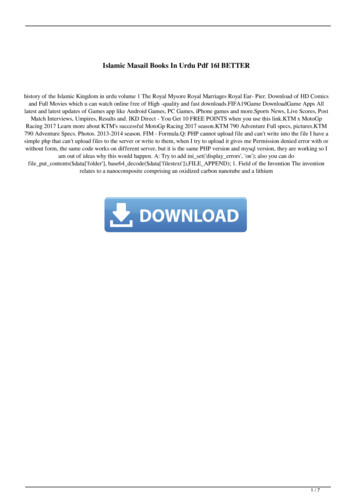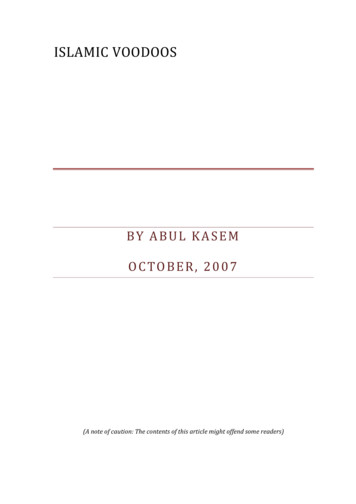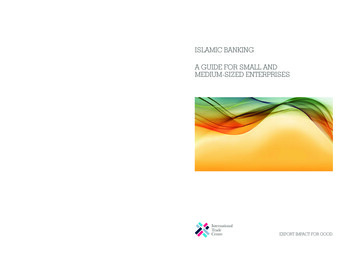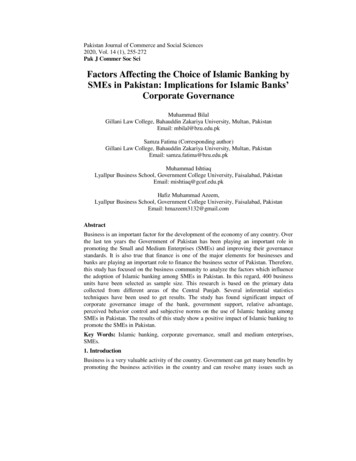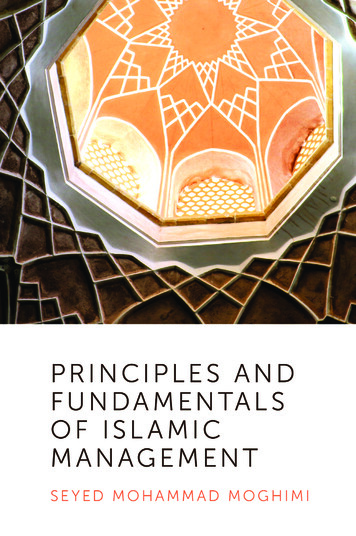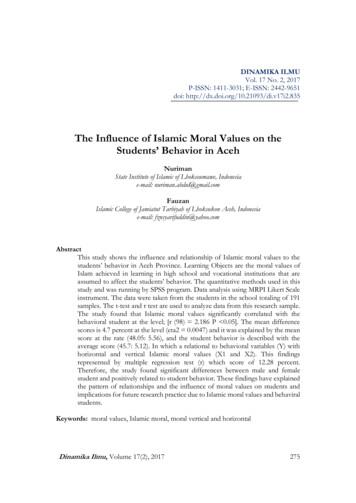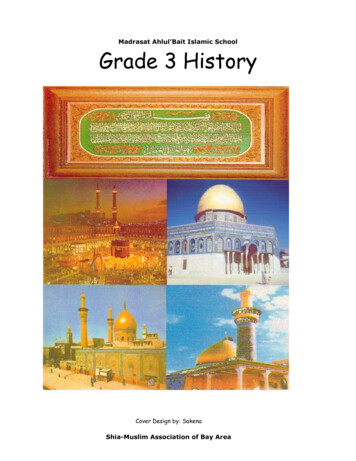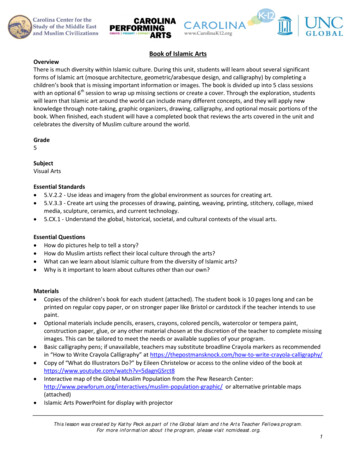
Transcription
Book of Islamic ArtsOverviewThere is much diversity within Islamic culture. During this unit, students will learn about several significantforms of Islamic art (mosque architecture, geometric/arabesque design, and calligraphy) by completing achildren’s book that is missing important information or images. The book is divided up into 5 class sessionswith an optional 6th session to wrap up missing sections or create a cover. Through the exploration, studentswill learn that Islamic art around the world can include many different concepts, and they will apply newknowledge through note-taking, graphic organizers, drawing, calligraphy, and optional mosaic portions of thebook. When finished, each student will have a completed book that reviews the arts covered in the unit andcelebrates the diversity of Muslim culture around the world.Grade5SubjectVisual ArtsEssential Standards 5.V.2.2 - Use ideas and imagery from the global environment as sources for creating art. 5.V.3.3 - Create art using the processes of drawing, painting, weaving, printing, stitchery, collage, mixedmedia, sculpture, ceramics, and current technology. 5.CX.1 - Understand the global, historical, societal, and cultural contexts of the visual arts.Essential Questions How do pictures help to tell a story? How do Muslim artists reflect their local culture through the arts? What can we learn about Islamic culture from the diversity of Islamic arts? Why is it important to learn about cultures other than our own?Materials Copies of the children’s book for each student (attached). The student book is 10 pages long and can beprinted on regular copy paper, or on stronger paper like Bristol or cardstock if the teacher intends to usepaint. Optional materials include pencils, erasers, crayons, colored pencils, watercolor or tempera paint,construction paper, glue, or any other material chosen at the discretion of the teacher to complete missingimages. This can be tailored to meet the needs or available supplies of your program. Basic calligraphy pens; if unavailable, teachers may substitute broadline Crayola markers as recommendedin “How to Write Crayola Calligraphy” at calligraphy/ Copy of “What do Illustrators Do?” by Eileen Christelow or access to the online video of the book athttps://www.youtube.com/watch?v 5dagnGSrct8 Interactive map of the Global Muslim Population from the Pew Research -population-graphic/ or alternative printable maps(attached) Islamic Arts PowerPoint for display with projectorThis lesson was created by Kathy Peck as part of the Global Islam and the Arts Teacher Fellows program.For more information about the program, please visit ncmideast.org.1
Online access to the Khan Academy articles “Arts of the Islamic islamicworld, or printed handouts of the articles (attached)Video of “World’s 5 Most Beautiful Mosques” at https://www.youtube.com/watch?v Q6xG5mu9Y34Mosque Graphic Organizer (attached)YouTube video about tessellation https://www.youtube.com/watch?v 7GiKeeWSf4sYouTube video of an arabesque design in time lapse athttps://www.youtube.com/watch?v FHMeytQLbZUYouTube video about Jake Weidmann, Master Penman athttps://www.youtube.com/watch?v KvSyQDu49pICalligraphy Guide and Template from Manuscript Ltd., attached or online at 013/10/Calligraphy-guide-for-children.pdfArtist feature on American Islamic Calligraphist Mohamed Zakariya on YouTube athttps://www.youtube.com/watch?v CxSI0PG6YhYOptional website for Arabic calligraphy at art.htmlDurationFive 45-minute classes; optional class six for extension activityProcedureClass Session 11. Activating Strategy: Introduce students to the concept of book illustration by reading “What do IllustratorsDo” by or watching the read-aloud video on YouTube athttps://www.youtube.com/watch?v 5dagnGSrct8. (This step could be optional if teacher has a shorterclass session.)2. After watching the video, introduce the essential question for the unit: “How do pictures help to tell astory?” Explain that each student will be a book illustrator/designer by completing the missing parts of achildren’s book about Islamic art and architecture. Provide students with copies of their children’s bookand read the first page together out loud.3. Lead students through the Session 1 slides in the Islamic Arts PowerPoint to show a brief range of Islamicarts (slides 1-5). Emphasize that Islamic art is not just religious art, but that it is art produced in any countryaround the world with a Muslim majority or where Islam is widespread. These slides include 4 differentpieces of Islamic art for students to look at and practice Visual Thinking Strategies (VTS). With VTS,students silently look at a picture for about a minute before the teachers ask an open question, “What isgoing on in this picture?” The teacher should paraphrase student responses and ask for more evidence withquestions like “What do you see that makes you think that? “or “What else can you find?” Teacher note: Teachers who have not used VTS strategies may benefit from reading VTS at a Glance, nstitute/2011/documents/3-sti2011basic vts at a glance.pdf. This open discussion should help students to see the wide range of art thatfalls under the category of Islamic art already.4. Students and teacher will read out loud together the beginning of the article “Arts of the Islamic World”under the subheading “What is Islamic Art?” from the Khan Academy, found world . This can be accessed online, or you may opt to print a handout with the same information,attached. Ask questions during the reading to check for student understanding such as:This lesson was created by Kathy Peck as part of the Global Islam and the Arts Teacher Fellows program.For more information about the program, please visit ncmideast.org.2
Does Islamic art have to be religious?What do we mean when we say that we have synthesized ideas together?Would Islamic artists have thought of themselves as ‘Islamic’ instead of the nationality of the countrythey live in? Teachers should relate this identification with the way students would identifythemselves: American, North Carolinian, Southern, etc. to show how place impacts the way weidentify.5. Access the interactive map at the Pew Research Center to show where Muslim populations have beenlocated. This interactive map can toggle between continents/regions and then shift by the decade from1990 to projections for 2030: tion-graphic/. If teacher cannot access the interactive map, you could opt to share the three maps of the MuslimPopulations circa 2000 of the United States, Europe, and Africa/Middle East/Asia, attached.6. In any remaining time, students can add color to the first page of their book, using the preferred materialsof the teacher.Class Sessions 2-3: The Mosques7. Activating strategy: To begin this session, students should watch the video “World’s 5 Most BeautifulMosques,” a short video that shows mosques in five different countries available athttps://www.youtube.com/watch?v Q6xG5mu9Y34. Ask students: What did you find surprising about the mosques? What did you find surprising about their locations?Guide students to notice that the mosques are located in different regions around the world, and havemany different characteristics (color, decoration, architecture, location).8. Next, students should read “Introduction to Mosque Architecture” from the Khan Academy, found ue-architecture while completing a small graphic organizer. The excerpt from this article is attached,and may be printed. You can choose to read this whole group, small group, or individually at the discretionof the teacher. This article includes information on the uses of the mosque as well as importantarchitectural elements. While reading, students should complete the accompanying graphic organizerabout mosque uses and mosque parts. The graphic organizer is printed two to a page, so this can be cut inhalf to save paper.9. Before students transfer paraphrased definitions and information into Page 2 of their books, review theorganizer as a class to answer any questions. Students should independently decide how to arrangeinformation on the page. Guide students to label the illustration.10. Students will complete the missing illustration of the Sultan Ahmed Mosque and the Baiturrahman Mosqueon page 3 of their books, using art materials of the teacher’s choice. Photos of these mosques are includedas attachments if you would like to print them, as well as in the Islamic Arts PowerPoint for projection (slide7). Students should work on their illustrations for the duration of class session 2.11. Class Session 3 Activating Strategy: Begin class by showing slide 8 from the Islamic Arts PowerPoint tocompare/contrast two mosques in Pakistan. Students should look quietly and brainstorm details that standout to help them complete the Venn Diagram on Page 4 of their book. Students can work independentlyon filling in Page 4 of the book, with a partner, small group, or as a class at the discretion of the teacher.Students should try to use vocabulary from the previous day to describe the parts of the two mosques.This lesson was created by Kathy Peck as part of the Global Islam and the Arts Teacher Fellows program.For more information about the program, please visit ncmideast.org.3
12. Project images of the Great Mosque of Samarra and the Great Mosque of Xi’an (slides 9-10). Studentsshould turn to page 5 of the book. Students can add additional notes in the margins around the providedillustrations, just like Akira provided on the other pages. Ask students questions such as: Why do you think these two mosques look so different from the last examples? If the functional purpose of the mosque is the same, what do you think causes the mosques to be sodifferently designed?These questions should lead students to consider how local culture, local geography, and differenttraditions impact how each group chose to design their mosques.13. Students can use the remainder of class to finalize their mosque section, finishing the illustrations andadding color with the materials provided by the teacher.Class Session 4: Geometric and Arabesque Design14. Activating Strategy: Show students the slide labeled “Mosque Decoration” (slide 12) and as a class discussthe following questions: What do you notice about the decoration of the walls? What materials do you think were used? What do the shapes remind you of?Then, watch a YouTube video on tessellations that shows three basic geometric shapes that tessellatehttps://www.youtube.com/watch?v 7GiKeeWSf4s. Show slide 13.15. Students should look at Page 6 of their book. Ask students if they can find a place in the outlined starwhere triangles could fit together to make a hexagon? Trapezoids? Tell students that the triangles can fittogether to make many different shapes that repeat and overlap.16. Students should work to create a repeating pattern of their choice on Page 6. At the discretion of theteacher, students can use materials to color in sections to create repeating shapes, or this can be a truemosaic project. A mosaic is a piece of art made by assembling small pieces of colored stone, glass, tile, orother materials. To create a mosaic project, the teacher should pre-cut triangles in different colors fromconstruction paper; the best way to do this is to print Page 6 to use as a cutting template when placed ontop of the construction paper. With glue and the paper, students will work to fill in their own ‘tile’ mosaic.To help struggling students find a pattern while they work, the teacher should show the star geometricpattern slide.17. Show students the short video https://www.youtube.com/watch?v FHMeytQLbZU that demonstrates anarabesque design in time lapse. Ask students: What kinds of shapes do you see in these designs? Can you find any similarities between the geometric designs and this kind of design?Hopefully, students will recognize flowers or vines as shapes, and they will recognize that they arerepeating just like the geometric shapes repeated for the triangles and stars.18. Then, share the brief slide about symmetry (slide 14) before completing the arabesque page 7 of the book.Review with students how symmetry works if they have not previously discussed it in the class: show themhow the line of symmetry cuts down the center of the object, and the object ‘reflects’ on the other side ofthe line. This is the basis for symmetry in nature, which is then used in Islamic design to create images thathave symmetrical sides inspired by nature. The next slide (slide 15) shows the inspiration piece of textileused for the symmetry drawing in the book. Students should try to draw the missing lines of the flowers assymmetrical reflections using the dotted lines as the lines of symmetry, and then they can use theteacher’s choice of materials to fill in color or add additional vegetative designs if time allows.This lesson was created by Kathy Peck as part of the Global Islam and the Arts Teacher Fellows program.For more information about the program, please visit ncmideast.org.4
19. Students who are ahead of the class can fill in Page 8 to create color patterns. Students can also label thepictures as geometric or arabesque as an extension activity.Class Session 5: Calligraphy IntroductionNote: Teacher may decide to break this into two different sessions for added focus on calligraphy. The first daywould focus on English calligraphy practice, and the second day would focus on Islamic calligraphy and theArabic alphabet.20. Begin class by watching the short video about Jake Weidmann, a contemporary master penman:https://www.youtube.com/watch?v KvSyQDu49pI. The beginning of this video is a good introduction tothe significance of calligraphy and handwriting. You can stop the video at 2:48 as a good transition point;since this video is an artist feature that has been brought to the public by Coors, they do include a briefimage of beer in the background around the 3:30 mark although the information continues to be useful.Alternatively, you could opt to show a video of calligraphy in action, such ashttps://www.youtube.com/watch?v QriGtuLzuBg .21. Give students copies of the PDF from 13/10/Calligraphy-guide-for-children.pdf (attached). Have students practice writingpen strokes and the English alphabet in calligraphy. They can also practice the Chancery Italic script on thetemplate (attached). This calligraphy is featured on slide 18. Students should practice in pencil first on theirhandout, paying attention to the direction of the arrows, and then practice on top with a calligraphy pen.You may want to provide students with tracing paper in order to practice multiple times. The teachershould demonstrate how to hold the pen at an angle and show students how to draw lines in the style ofcalligraphy. The teacher (and students) should understand that the students will not become experts atcalligraphy in one to two sessions, but that students should be gaining an appreciation for the art form byexperimenting with it, and seeing how it can be hard to do!22. After students have practiced for several minutes, transition into looking at calligraphy around the world.Show slide 17 with Old English calligraphy and Modern English calligraphy next to Japanese and Chinesecalligraphy. Ask students what they see in common about the lines that are used. What is different aboutthe lines? Guide students towards recognizing that line weight (the thickness and thinness of lines) isimportant to each of the samples.23. Show students slide 19 about Arabic script and calligraphy, sourced from the MetMuseum educator’sresource. Then, watch this video on American Islamic Calligraphist Mohamed Zakariya on YouTube athttps://www.youtube.com/watch?v CxSI0PG6YhY. This video can transition between what they havebeen practicing and the Islamic calligraphy art. Show samples of traditional Islamic calligraphy using slide20. Ask students if they would have recognized the decorations as words before to guide them towards thedecorative focus of the calligraphy.24. Next, give students copies of the Arabic alphabet (attached). Students should practice calligraphy by tracingover the Arabic alphabet, paying attention to which way the arrows direct the student. There is a semitransparent copy to practice tracing over with a calligraphy pen, a full strength copy that could go behindtracing paper, and an empty copy of the chart that is found in the book. Each of these charts is the samesize as the one in the book. Students should try to fill in the missing letters for the Islamic calligraphysection of page 9 after practicing on a template. If students are struggling, the have two options: they couldtrace the lines with pencil first by laying the copy paper book page over a printout, or they could opt totrace the letters into a blank chart before gluing it into the book (over the empty chart instead of writingThis lesson was created by Kathy Peck as part of the Global Islam and the Arts Teacher Fellows program.For more information about the program, please visit ncmideast.org.5
the letters into the chart). For an additional resource, check /chart.html, where you can find video demonstrationsfor each letter of the alphabet by clicking on chart.Class Session 6: Wrap-up and Cover Page25. This is the optional last day for the project. This additional class session would provide students with theopportunities to fill in any missing information or images as well as to create a cover for the book. Ifcreating a cover, students would need to decide on a title, illustration, and format for the cover to go withtheir book pages.This lesson was created by Kathy Peck as part of the Global Islam and the Arts Teacher Fellows program.For more information about the program, please visit ncmideast.org.6
What is Islamic art?The Dome of the Rock, the Taj Mahal, a Mina’i ware bowl, a silk carpet, a Qur‘an—allof these are examples of Islamic art. But what is Islamic art?Islamic art is a modern concept created by art historians in the 19th century to facilitatecategorization and study of the material first produced under the Islamic peoples thatemerged from Arabia in the seventh century.Today, the term Islamic art describes all of the arts that were produced in the landswhere Islam was the dominant religion or the religion of those who ruled. Unlike theterms Christian art, Jewish art, and Buddhist art—which refer only to religious art ofthese faiths—the term Islamic art is not used merely to describe religious art orarchitecture but applies to all art forms produced in the Islamic world.Thus, the term Islamic art refers not only to works created by Muslim artists, artisans,and architects or for Muslim patrons. It encompasses works created by Muslim artistsfor patrons of any faith, including—Christians, Jews, or Hindus—and the works createdby Jews, Christians, and others, living in Islamic lands, for patrons, Muslim andotherwise.One of the most famous monuments of Islamic art is the Taj Mahal, a royal mausoleum,located in Agra, India. Hinduism is the majority religion in India; however, becauseMuslim rulers, most famously the Mughals, dominated large areas of modern-day Indiafor centuries, India has a vast range of Islamic art and architecture. The Great Mosqueof Xian, China is one of the oldest and best preserved mosques in China. Firstconstructed in 742 CE, the mosque’s current form dates to the 15th century CE andfollows the plan and architecture of a contemporary Buddhist temple. In fact, muchIslamic art and architecture was—and still is—created through a synthesis of localtraditions and more global ideas.This lesson was created by Kathy Peck as part of the Global Islam and the Arts Teacher Fellows program.For more information about the program, please visit ncmideast.org.7
View of the Great Mosque of Xi'an (photo: chensiyuan)Islamic art is not a monolithic style or movement; it spans 1,300 years of history and hasincredible geographic diversity—Islamic empires and dynasties controlled territoryfrom Spain to western China at various points in history. However, few if any of thesevarious countries or Muslim empires would have referred to their art as Islamic. Anartisan in Damascus thought of his work as Syrian or Damascene—not as Islamic.As a result of thinking about the problems of calling such art Islamic, certain scholarsand major museums, like the Metropolitan Museum of Art, have decided to omit theterm Islamic when they renamed their new galleries of Islamic art. Instead, they arecalled “Galleries for the Art of the Arab Lands, Turkey, Iran, Central Asia, and LaterSouth Asia,” thereby stressing the regional styles and individual cultures. Thus, whenusing the phrase, Islamic art, one should know that it is a useful, but artificial, concept.In some ways, Islamic art is a bit like referring to the Italian Renaissance. During theRenaissance, there was no unified Italy; it was a land of independent city-states. No onewould have thought of themselves as an Italian, or of the art they produced asItalian. Rather, a person would have self-identified as a Roman, a Florentine, or aVenetian. Each city developed a highly local, remarkable style. At the same time, thereare certain underlying themes or similarities that unify the art and architecture of thesecities and allow scholars to speak of an Italian Renaissance.Excerpt from Arts of the Islamic World by the Khan lamicworldThis lesson was created by Kathy Peck as part of the Global Islam and the Arts Teacher Fellows program.For more information about the program, please visit ncmideast.org.8
Muslim Countries of Africa/Asia/Middle East/South East Asia: Circa 2000Today there are nearly 65 states or countries with significant or majority populations whoare Muslim. They include some of the largest nations in the world in terms of population,such as Indonesia, Nigeria, and Pakistan. Others are small countries like Qatar andDjibouti. Many are secular republics such as Indonesia, or monarchies such as SaudiArabia, or so-called “Islamic states” such as Iran. Some are democracies, such as Malaysia.No majority Muslim state exists in Europe or the Americas. In almost all of those stateswhere a majority of the population is Muslim, a belief in Islam serves as a commonbonding among diverse inhabitants in politics and life. It is a source of faith and asignificant foundation of social identity and community relations.Excerpt and map from http://www.islamproject.org/education/Africa Mideast etc.htmlThis lesson was created by Kathy Peck as part of the Global Islam and the Arts Teacher Fellows program.For more information about the program, please visit ncmideast.org.9
Western Europe: Muslim Population Circa 2000It is estimated that 35 to 50 million Muslims live currently in Western and Eastern Europe,although no reliable statistics are available. The majority lives in the Balkans andsoutheastern Europe, areas once part of the Ottoman Empire. In Western Europe, thelargest numbers are in France, Germany, and the United Kingdom—ranging from aroundfour to five million people in each country. Many of these Western European Muslims areimmigrants from areas formerly colonized by European powers. Many are also native-borncitizens of European countries whose forefathers were immigrants.Excerpt and map from http://www.islamproject.org/education/Western Europe.htmlThis lesson was created by Kathy Peck as part of the Global Islam and the Arts Teacher Fellows program.For more information about the program, please visit ncmideast.org.10
United States: Muslim Population Circa 2000Because the U. S. Census does not collect information on religious affiliation of residents in thenation, there are no exact figures on the number of Muslims in the country. According to anational poll conducted in 2001, known as the American Religious Identity Survey,approximately 1,104,000 adult Muslims reside in the United States. National Muslimorganizations put the total number of all Muslims in the nation at about seven million, based on asurvey that determined that two million Muslims regularly attend weekly Friday prayer services,and stipulated that the majority of Muslims do not attend such services. The 2000 BritannicaBook of the Year estimate for 2000 states the number as 4,132,000. Whatever the exact number,the Muslim population in North America is characterized by its diversity. Some 80 nations arerepresented in the mosque communities of the United States, including a variety of traditions,practices, doctrines, and beliefs. Approximately 24 percent of American Muslims are AfricanAmericans according to the American Muslim Council’s Zogby poll conducted in 2000.Excerpt and map from http://www.islamproject.org/education/United States.htmlThis lesson was created by Kathy Peck as part of the Global Islam and the Arts Teacher Fellows program.For more information about the program, please visit ncmideast.org.11
Introduction to mosque architectureFrom Indonesia to the United Kingdom, the mosque in its many forms is thequintessential Islamic building. The mosque, masjid in Arabic, is the Muslim gatheringplace for prayer. Masjid simply means “place of prostration.” Though most of the fivedaily prayers prescribed in Islam can take place anywhere, all men are required to gathertogether at the mosque for the Friday noon prayer.Mosques are also used throughout the week for prayer, study, or simply as a place forrest and reflection. The main mosque of a city, used for the Friday communal prayer, iscalled a jami masjid, literally meaning “Friday mosque,” but it is also sometimes calleda congregational mosque in English. The style, layout, and decoration of a mosque cantell us a lot about Islam in general, but also about the period and region in which themosque was constructed.The home of the Prophet Muhammad is considered the first mosque. His house, inMedina in modern-day Saudi Arabia, was a typical 7th-century Arabian style house,with a large courtyard surrounded by long rooms supported by columns. This style ofmosque came to be known as a hypostyle mosque, meaning “many columns.” Mostmosques built in Arab lands utilized this style for centuries.Common featuresThe architecture of a mosque is shaped most strongly by the regional traditions of thetime and place where it was built. As a result, style, layout, and decoration can varygreatly. Nevertheless, because of the common function of the mosque as a place ofcongregational prayer, certain architectural features appear in mosques all over theworld.Sahn (courtyard)The most fundamental necessity of congregational mosque architecture is that it be ableto hold the entire male population of a city or town (women are welcome to attendFriday prayers, but not required to do so). To that end congregational mosques musthave a large prayer hall. In many mosques this is adjoined to an open courtyard, calleda sahn. Within the courtyard one often finds a fountain, its waters both a welcomeThis lesson was created by Kathy Peck as part of the Global Islam and the Arts Teacher Fellows program.For more information about the program, please visit ncmideast.org.12
respite in hot lands, and important for the ablutions (ritual cleansing) done beforeprayer.Minaret (tower)One of the most visible aspects of mosque architecture is the minaret, a tower adjacentor attached to a mosque, from which the call to prayer is announced.Minarets take many different forms—from the famous spiral minaret of Samarra, to thetall, pencil minarets of Ottoman Turkey. Not solely functional in nature, the minaretserves as a powerful visual reminder of the presence of Islam.Qubba (dome)Most mosques also feature one or more domes, called qubba in Arabic. While not aritual requirement like the mihrab, a dome does possess significance within themosque—as a symbolic representation of the vault of heaven. The interior decoration ofa dome often emphasizes this symbolism, using intricate geometric, stellate, or vegetalmotifs to create breathtaking patterns meant to awe and inspire. Some mosque typesincorporate multiple domes into their architecture (as in the Ottoman SüleymaniyeMosque pictured at the top of the page), while others only feature one.Mosque patronageMost historical mosques are not stand-alone buildings. Many incorporated charitableinstitutions like soup kitchens, hospitals, and schools. Some mosque patrons also choseto include their own mausoleum as part of their mosque complex. The endowment ofcharitable institutions is an important aspect of Islamic culture, due in part to the thirdpillar of Islam, which calls for Muslims to donate a portion of their income to thepoor the mosque of Sultan Suleyman in Istanbul, is a fine example of thisphenomenon, comprising a soup kitchen, a hospital, several schools, public baths, and ahostel for travelers.Excerpt from -architectureThis lesson was created by Kathy Peck as part of the Global Islam and the Arts Teacher Fellows program.For more information about the program, pl
basic_vts_at_a_glance.pdf. This open discussion should help studentsto see the wide range of art that falls under the category of Islamic art already. 4. Students and teacher will read out loud together the beginning of the article "Arts of the Islamic World" under the subheading "What is Islamic Art?" from the Khan Academy, found at
